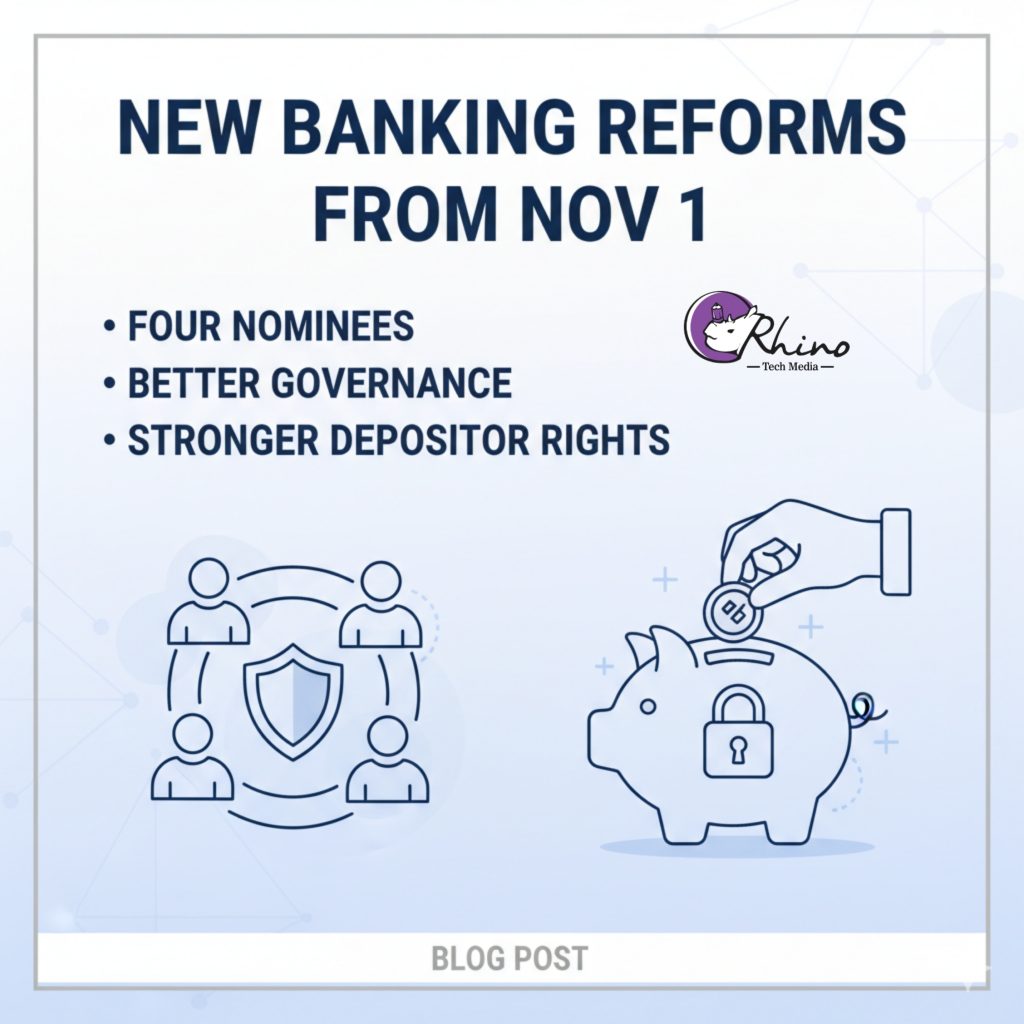Introduction
The Indian Government, via the Ministry of Finance, has announced that several key provisions of the Banking Laws (Amendment) Act, 2025 will come into force from 1 November 2025. These provisions reflect a concerted push to modernise banking legal frameworks — aligning with evolving regulatory standards, improving depositor protections, strengthening bank governance, and improving the customer experience. The reforms arise amid a broader environment of financial inclusion, increasing use of banking services, and a growing recognition that legal/operational frameworks must stay ahead of consumer needs.
Key Features of the Reform
1. Up to Four Nominees in Deposit Accounts and Lockers
One of the most tangible changes for everyday bank customers is that from 1 November, account-holders can name up to four nominees on their bank deposit accounts. This departs from the earlier norm of typically just one nominee. The reforms allow:
- Simultaneous nomination: all up to four nominees receive, in the proportion specified (which must add up to 100 %) simultaneously.
- Successive nomination: where nominees are ranked, and the next nominee becomes operative only when the earlier nominee(s) have died.
- For lockers or articles in safe custody, the nomination route will permit only successive nominations (not simultaneous).
This is intended to simplify the transmission of funds/assets to beneficiaries, reduce legal entanglements, avoid delays, and improve clarity for families or successors.
2. Enhanced Governance and Depositor/Investor Protection
Beyond the nomination framework, the Amendment Act introduces a host of governance-related changes for banks and related institutions:
- The Act allows public sector banks (PSBs) to transfer unclaimed shares, unclaimed interest, and bond-redemption amounts to the Investor Education and Protection Fund (IEPF) — aligning banking practice with that in company law.
- It empowers PSBs to determine the remuneration for statutory auditors — a move aimed at improving audit quality and governance credibility.
- The threshold for what constitutes “substantial interest” in a bank has been raised (from ₹5 lakh to ₹2 crore) — the first revision since 1968.
- For cooperative banks, the maximum tenure of directors (excluding chairpersons and whole-time directors) is extended from 8 to 10 years, aligning with the 97th Constitutional Amendment.
- It mandates uniform reporting by banks to the Reserve Bank of India (RBI) and other regulatory enhancements.
In essence, these changes are designed to bring the banking legal framework up to date, improve transparency, strengthen depositor trust and protect investors, while also reducing legacy regulatory bottlenecks.
Implications and Rationale
For Depositors and Account-Holders
From the depositors’ standpoint the reforms are significant. Being able to nominate up to four people — and choose how the share is allocated — provides far greater flexibility in estate planning. It also helps reduce litigation or delays when a depositor passes away or is incapacitated. This is especially beneficial in a country like India where many small depositors may not have elaborate wills or have complex family structures. By standardising nominations, banks can streamline claim settlements, reducing the burden on both the bank and the claimants.
For Banks and Governance
For banks, the reforms place greater emphasis on governance, audit quality, reporting standards and transparency. That enhances overall sectoral stability and may reduce operational risk due to unclear claims or succession disputes. Additionally, aligning nomination rules across deposit accounts, lockers and safe-custody items simplifies internal processes.
For the Financial System
At a macro level, improving depositor rights, streamlining nominations, and reducing the backlog of unclaimed assets all contribute towards a healthier banking ecosystem. The reforms also bring India’s banking legal regime closer to international norms of consumer protection and succession clarity. According to one source, unclaimed deposits in PSBs as of June 2025 stood at over ₹58,330 crore, with private banks at ₹8,673.72-crore — improving claim settlement efficiency could help reduce this burden.
Challenges and Considerations
While the reforms are broadly welcome, several considerations merit attention:
- Operationalisation: The actual translation of the law into bank forms, standardised procedures, and staff training will be key. The government has indicated that the Banking Companies (Nomination) Rules, 2025 will detail the procedure and forms in due course. Delays or inconsistent implementation across banks could reduce effectiveness.
- Awareness: Depositors need to be informed of their new rights (e.g., ability to have multiple nominees, specify percentage shares, choose simultaneous vs successive). Without awareness, many may continue as before, losing the benefits.
- Locker / Safe custody assets: For articles in safe custody and safety lockers, only successive nominations are permitted — this may limit flexibility for some depositors.
- Nomination ≠ heirship: It’s important to emphasise that nomination is not the same as legal heirship. The nominee merely receives the proceeds; legal heirs may still have claims depending on circumstances. Some commentary (e.g., older reforms) caution that a nominee is essentially a trustee and the estate may still owe to heirs.
- System readiness: Banks need to update their internal systems (digital and manual), nomination modules, share allocation logic, safe-custody processes, and training. Any lag may lead to customer dissatisfaction.
- Risk of complexity: Allowing up to four nominees and proportional shares adds complexity (especially for smaller banks) that previously operated with simpler one-nominee regimes. Ensuring that banks handle the change seamlessly is key.
Conclusion
The reforms coming into effect on 1 November 2025 under the Banking Laws (Amendment) Act bring a meaningful step‐change in Indian banking — particularly in empowering depositors, improving nomination flexibility, and strengthening governance. For customers, the ability to have up to four nominees (with either simultaneous or successive nomination modes) provides greater control and clarity. For the banking system, enhanced governance rules, stricter audit & reporting norms, and clearer succession mechanisms contribute to a more robust financial ecosystem.
However, as always, the impact will depend heavily on implementation — how well banks update their processes, how quickly awareness spreads among depositors, and whether the expected legal/operational benefits translate into smoother claim settlements and fewer disputes. In the coming months, monitoring how banks roll out the changes, how claim settlement metrics evolve, and whether depositor satisfaction rises will be important indicators of success.
In sum, this reform can be seen as part of a broader narrative: moving India’s banking laws from being legacy‐oriented to more modern, customer-centric and transparent. If implemented well, it could meaningfully enhance trust in the system, reduce friction for depositors, and improve governance standards.

